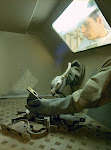It is Time to Vacate Occupied Construction
I am finishing up a three-month complete kitchen remodel at
my house and have had my fill of the chaos, clutter, and disarray. If you have
ever remodeled the most used room in your house, you know what I’m talking
about. It got so bad the other night that I was accused of displaying male
menopause behavior. While I have been complaining about the endless hours of
work and the omnipresent dust, it made me think about the challenges we have in
performing construction work on occupied buildings. I would submit that
restoration work on occupied buildings is becoming increasingly more
challenging for the construction team. What was once a common practice is now
complicated by legal battles and exorbitant costs to accommodate the occupants.
Unfortunately, I think our days of working on occupied commercial buildings are
soon to come to an end.
Since Re-View specializes in restoring historic windows on
national landmarks across the country, we have a great deal of background in
working on occupied structures. Over the past ten years, we have seen a
dramatic increase in conflict related to the work being performed. The construction
process affects the atmosphere of an occupied environment. In addition to the
noise and displacement associated with construction, occupants are subjected to
dust resulting from activities like masonry restoration, demolition, and
plaster repair. Fumes from new materials, finishes or adhesives also cause an
invasion of foreign material. The
Centers for Disease Control and Prevention (CDC) outlines the impacts of particulates,
biological materials and Volatile Organic Compounds (VOCs). Terms like Sick
Building Syndrome (SBS) are becoming commonplace. Other terms such as mesothelioma
and silicosis [ are
becoming known to the general population. The effects of mold were well
documented in the 90’s. Basically, advertising by attorneys and the
proliferation of material on the internet has made the general public very well
informed on all the dangers associated with occupied construction work.
It’s hard to find someone who is not familiar with the
growth of all types of litigation over the past thirty years. Cases such as the
McDonalds coffee lawsuit, tobacco litigation, and new forays into suing
purveyors of junk food are universally known. Children are even suing their
parents these days. One of the fastest growing segments in the advertising industry is the legal field. The proliferation of radio, television, and billboard advertising for legal
services over the past ten years is staggering. What this means is that your
construction project can easily become fodder for the next big legal revenue
opportunity.
While the legal field has been ramping up its efforts to
drum up business, there has been a change in mentality of the typical American.
There is a growing segment of our population that has become conditioned to the
concept of getting something for nothing. The rampant rise in gambling is a
direct result of this shift in mentality. Opportunists see frequent examples of
people scoring million dollar awards at the local casino and read about the
latest Powerball or Mega Millions winners. This behavior has also given birth
to what is called the legal lottery where people are using lawsuits to score
their next windfall.
What does this mean to the construction industry? If you are
an owner, architect, general contractor, or supplier you are in the cross hairs
of this trend and it is only getting worse. There are things that can be done
to mitigate exposure such as more efficient containment, training, testing, and
stricter project management. New developments in low VOC finishes and materials
are a positive development. If matters continue to get worse, however, the renovation
of occupied spaces may become a thing of the past.









